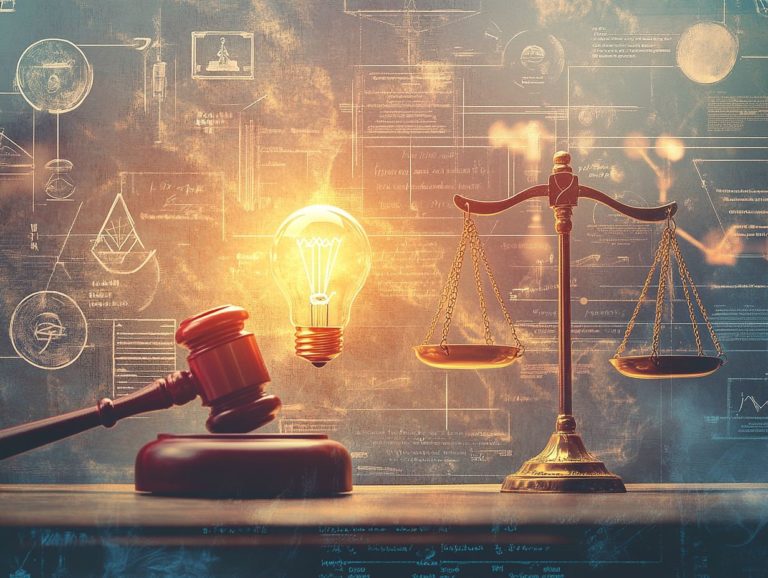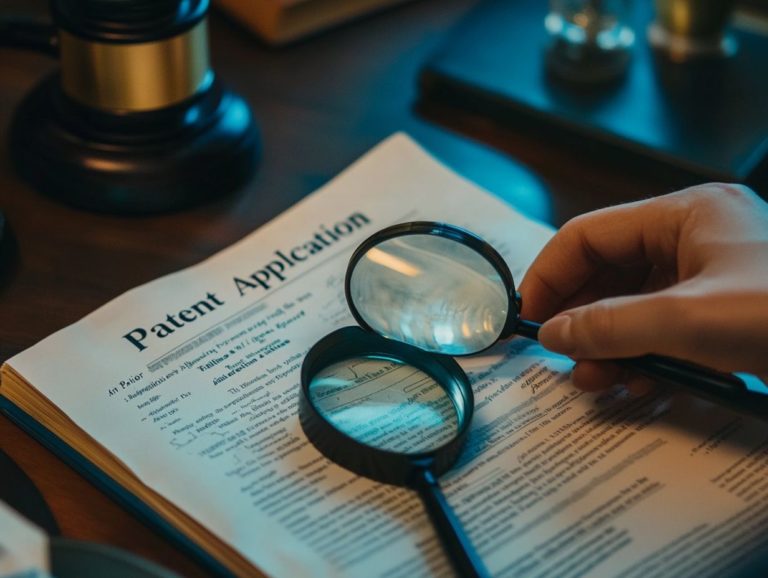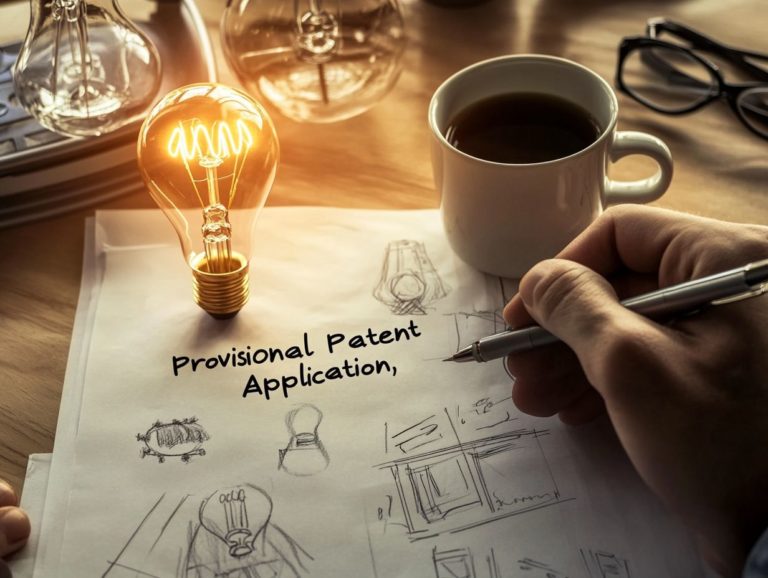Understanding Patent Ownership Disputes
Navigating the world of patent ownership can feel like a maze but don t worry! We re here to guide you. Patent ownership disputes can be intricate and often contentious, affecting inventors, businesses, and the broader landscape of innovation. This guide offers essential definitions that establish a solid foundation for comprehending these conflicts.
It delves into common causes, including infringement and contractual issues. We also discuss effective legal avenues for resolution. You ll find best practices for preventing disputes, ensuring your intellectual property remains safeguarded.
Whether you re an inventor or a business owner, this guide equips you with valuable insights to navigate the complex realm of patent ownership.
Contents
Key Takeaways:

- Patent ownership disputes can arise due to infringement, contractual conflicts, and other reasons.
- Legal options and processes, as well as effective communication and collaboration, are key to resolving patent ownership disputes.
- Prevent disputes by clearly defining terms in ownership agreements.
- Follow best practices, such as conducting thorough patent searches and maintaining open communication with co-owners.
What is a Patent Ownership Dispute?
A patent ownership dispute arises when there is a contention regarding who genuinely holds the rights to a patent. This often involves parties in complicated legal battles surrounding patent applications and assignments.
Such disputes can stem from various circumstances. These include disagreements among co-inventors, challenges to a patent’s validity, or infringement claims that escalate into legal skirmishes in federal district courts.
Grasping the nuances of patent ownership disputes is crucial for patent holders, businesses, and inventors as the realm of intellectual property continues to evolve.
Defining Key Terms

Understanding patent ownership begins with grasping key terms such as patent ownership, special rights, and patent protections essential elements for navigating the complex legal terrain of intellectual property.
Patent ownership encompasses the legal rights granted to you or your organization. These rights allow you to use, create, sell, or distribute a specific invention, giving you the power to prevent others from exploiting your invention without your permission.
Patent protections define the scope of what your patent covers. Various types of patents exist, including:
- Utility patents: Protect new and useful processes, machines, or compositions of matter.
- Design patents: Safeguard the ornamental features of a product.
- Plant patents: Designated for new varieties of plants.
Understanding these concepts is crucial for resolving patent disputes, as they directly influence the rights and obligations of all parties involved.
Common Causes of Patent Ownership Disputes
Patent ownership disputes can emerge from a range of factors. These include litigation over infringement claims and contractual disagreements.
Misunderstandings regarding joint ownership among inventors and patent holders can also lead to disputes. Each of these issues has the potential to result in substantial litigation costs and significant damages awarded.
Infringement and Misuse of Patents

Infringement and misuse of patents can take several forms. This includes direct infringement, indirect infringement, and other activities that violate the special rights of a patent holder.
Understanding these nuances is essential, whether you re an innovator or a business leader. Direct infringement typically occurs when someone makes, uses, or sells a patented invention without permission.
Indirect infringement, on the other hand, can arise through contributory actions or the encouragement of others to infringe. Such violations can prompt patent holders to seek legal remedies.
These remedies may include injunctions aimed at stopping further infringement or claims for reasonable royalties, where patent holders seek compensation that reflects what they would have earned through licensing.
Thus, grasping the intricacies of patent rights and the potential repercussions of infringement is vital for maintaining a competitive edge in today s innovation-driven market.
Contractual Conflicts
Contractual conflicts often arise from unclear licensing agreements or patent agreements. These issues frequently occur among joint inventors and can lead to disputes over patent rights and costly legal actions.
When multiple parties develop a new invention, unclear terms can cause misunderstandings. This confusion can lead to disagreements over ownership and profit-sharing arrangements.
These disputes can turn into expensive legal battles, distracting inventors from their work and stifling innovation. Poorly defined agreements can have lasting impacts, so you must seek clarity in your contracts.
This will help safeguard your intellectual property and lower the risks of litigation.
Resolving Patent Ownership Disputes

To resolve patent ownership disputes, explore various legal options like civil lawsuits or negotiations. Your goal is to secure fair compensation for any damages awarded.
Legal Options and Processes
During a patent ownership dispute, it s vital to explore legal options, including filing a civil lawsuit. This process often involves navigating courtroom procedures and may require expert witnesses.
Gathering solid evidence is crucial to support your claims. You also need to identify the right jurisdiction for your case.
After filing, the pre-trial phase begins, and discovery is key to revealing the complexities of your situation. Partnering with skilled patent attorneys will guide you through procedures like depositions and summary judgment motions.
Expert witnesses add significant value to your case. Their specialized knowledge can clarify technical aspects that jurors might find challenging.
Preventing Patent Ownership Disputes
Proactively prevent patent ownership disputes by implementing best practices in your agreements. Effective communication among joint inventors is essential to ensure clarity about rights and responsibilities.
Establishing these foundations significantly lowers the chances of conflicts in the future.
Best Practices for Patent Ownership Agreements
Implementing best practices for patent ownership agreements is vital for clarity. Define each inventor’s role, contributions, and responsibilities in detail.
Clearly addressing rights related to patent ownership like licensing benefits and enforcement safeguards everyone s interests. This proactive approach improves communication and lays a strong foundation for resolving conflicts.
Effective Communication and Collaboration
Effective communication and collaboration among inventors are vital. They nurture strong relationships and prevent misunderstandings about patent ownership.
Engaging in open dialogue lays the groundwork for transparency. This clarity helps define each inventor’s contributions and aligns project goals.
By discussing roles and expectations early on, you can tackle potential challenges. Addressing issues upfront minimizes the chances of disputes.
Regular check-ins and feedback sessions help keep everyone aligned. This creates a collaborative atmosphere that boosts creativity and protects ownership rights.
Frequently Asked Questions
A patent ownership dispute is a legal disagreement about who owns a patent. This can occur when multiple parties believe they have rights to it.
These disputes can arise from disagreements over ideas, issues with joint inventors, or profit-sharing conflicts.
Unresolved disputes can lead to costly legal battles, delays in product launches, and damaged relationships.
Disputes can be resolved through negotiation, mediation, or litigation, depending on the situation and willingness to resolve.
Establish ownership rights clearly through contracts and agreements. Documenting the creation and development process is crucial.
No, disputes can occur between businesses, individuals, or both. Anyone involved in the creation may have a claim.
Let s tackle these disputes head-on! Consult a legal expert to ensure clear ownership rights.




